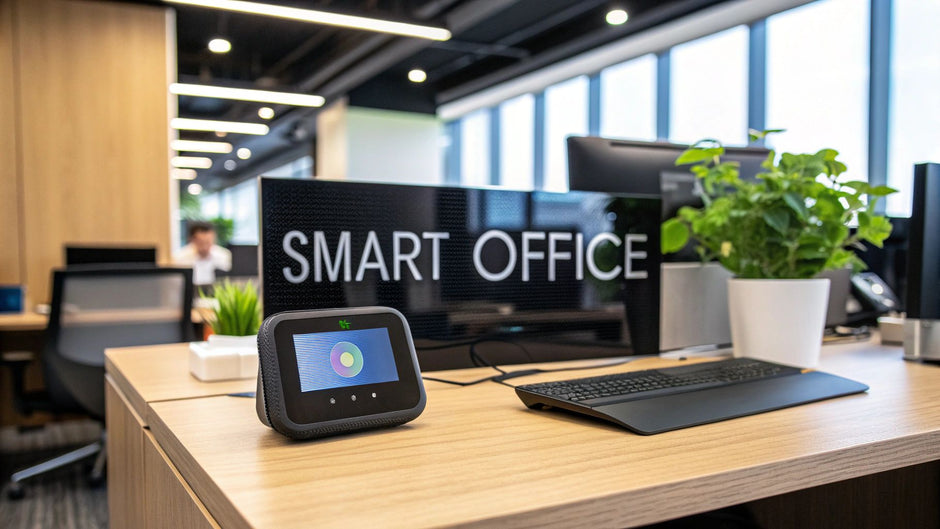Smart office technology isn't just a collection of cool gadgets; it's a fully connected ecosystem. Think of it as the central nervous system for your workplace, where devices, software, and sensors all talk to each other to create a smarter, more comfortable, and wildly more efficient environment. It goes way beyond simple automation to optimize daily operations and seriously upgrade the employee experience. To see how these components come together, you can explore our full collection of smart office solutions.
What Is Smart Office Technology Really
Picture walking into an office that already knows you're there. The lights in your area adjust automatically, your phone helps you find and book an available meeting room in seconds, and the facilities manager gets a heads-up that a projector bulb is about to die—long before it actually does. That’s the real promise of a smart office. It's not about siloed tech, but a responsive, data-rich environment that works for you.
At its core, this whole concept hinges on a few key ideas working together. You have automation to take care of the repetitive, mundane stuff. Then there's data analytics, which gives you incredible insight into how your workspace is actually being used. And tying it all together is user-centric design, ensuring the tech genuinely makes life better for the people in the building. It’s this combination that turns a static, brick-and-mortar space into a living, breathing workplace.
The Driving Force Behind Smart Workplaces
The move toward intelligent offices is much more than a passing trend—it’s a fundamental shift in how businesses operate. The global smart office market was valued at around USD 53.9 billion and is expected to rocket forward with a Compound Annual Growth Rate (CAGR) of about 13.9%. That puts it on track to blow past USD 128 billion by 2030. This isn't just hype; it's driven by a real, tangible need for better operational efficiency, happier employees, and serious cost savings.
This entire system is built on a web of interconnected devices. Fundamentally, smart office technology is deeply tied to Internet of Things (IoT) building automation. This is the magic that lets everyday objects—from thermostats and lights to security cameras and even coffee machines—connect, communicate, and share data.
A smart office uses interconnected technologies to learn from its occupants and environment, making continuous adjustments to enhance productivity, comfort, and resource efficiency. It’s a workspace that works for you, not the other way around.
To get a clearer picture of how these pieces fit together, let's break down the core components.
Core Components of a Smart Office
At the heart of any smart office are a few fundamental technologies that act as the building blocks. These systems work in concert to collect data, automate actions, and create a responsive environment for employees.
| Technology Category | Primary Function | Example Application |
|---|---|---|
| IoT Sensors | Collect real-time data about the physical environment. | Occupancy sensors detect if a room is empty to turn off lights. |
| Smart Lighting & HVAC | Automate and optimize environmental controls. | Adjusting temperature and lighting based on time of day or occupancy. |
| Connectivity (Wi-Fi, 5G) | Provide the high-speed network for all devices to communicate. | A stable network allowing hundreds of sensors to report data instantly. |
| Centralized Platform | A software "brain" to manage and analyze all the data. | A dashboard for facility managers to monitor energy use across the building. |
| Smart Access Control | Modernize building security and access. | Using a mobile app or keycard to enter the building and specific rooms. |
Each of these components plays a crucial role. Without reliable sensors, the system is blind. Without a strong network, it can't communicate. And without a central platform, it's just a bunch of disconnected data points.
Core Goals of a Smart Office
So, what's the end game here? What are we trying to achieve with all this tech? The goals are surprisingly straightforward and all about creating a workplace that’s both intelligent and deeply human.
- Boost Productivity: When you automate routine tasks like booking a room or fiddling with the thermostat, you free up people to focus on what actually matters—their work. Fewer distractions mean better output.
- Enhance Employee Experience: A comfortable, intuitive environment is a game-changer for job satisfaction. Think personalized lighting, ideal temperatures, and effortless navigation. It all adds up to a workplace people genuinely enjoy being in.
- Optimize Space Utilization: Ever wonder which desks and conference rooms are always empty? Smart office data tells you exactly how your space is being used. This helps companies make smart real estate decisions and stop paying for ghost offices.
- Increase Energy Efficiency: This one’s a no-brainer. Smart systems automatically power down lights, adjust the heat in empty rooms, and slash energy consumption. It’s great for the bottom line and even better for the planet.
The Building Blocks of a Smart Office
To really get what makes an office "smart," you have to look under the hood at the technologies that make it all happen. A smart office isn't just one product; it’s a whole ecosystem of devices and software working together. Think of it like a symphony—each instrument has its part, but together they create something seamless and powerful.
At the very heart of this symphony are the Internet of Things (IoT) sensors. These are the digital eyes and ears of the building, constantly gathering data about everything that’s going on. They're small and often hidden, but their impact is huge.
This massive network of sensors feeds a constant stream of information into a central system, allowing the office to react and adapt on the fly. Without them, a smart office would just be a pile of disconnected gadgets.
Sensing the Environment with IoT
IoT sensors are the foundation that almost all smart office technology is built on. They're responsible for collecting the raw data that fuels smart automation and gives you critical insights into how the workspace is actually being used.
These little devices can monitor a whole range of environmental conditions, making the workplace more comfortable, efficient, and safe.
- Occupancy Sensors: These know when someone is in a room or at a desk. For instance, if a meeting room is booked but stays empty for 15 minutes, the system can automatically free it up for someone else.
- Air Quality Monitors: These keep track of CO2 levels, humidity, and other airborne particles. If CO2 spikes in a crowded conference room, the system can kick in more fresh air, helping everyone stay sharp and focused.
- Light Sensors: These measure how much natural light is available. On a bright, sunny day, they can tell the smart lighting system to dim the lights near the windows, saving a ton of energy.
The data from these sensors doesn't just trigger immediate actions; it also builds a rich history. A facility manager can look at this data to spot long-term trends, like which parts of the office are always empty, which can help make smarter decisions about real estate and office design down the road.
Intelligent Climate and Lighting Control
One of the first things people notice in a smart office is how it handles climate and lighting. Old-school offices are notorious for their "thermostat wars" and harsh, one-size-fits-all lighting. Smart systems fix this by creating an environment that responds to what people actually need.
Smart HVAC systems, for example, are way more advanced than a simple programmable thermostat. They actually learn the building's occupancy patterns and can even pull in local weather forecasts.
Imagine an HVAC system that sees a heatwave coming and pre-cools the office during off-peak hours when energy is cheaper. It also knows which departments are nearly empty on a Friday afternoon and can scale back the heating or cooling in those areas, leading to some serious cost savings.
Smart lighting works in a similar way, adjusting not just to who's in the room but also to the natural rhythm of the day. It can even mimic the color of sunlight, providing bright, blue-toned light in the morning to help you wake up and shifting to warmer, softer tones in the afternoon to reduce eye strain.
Streamlining Security and Access
Forget about clunky keys and easy-to-lose keycards. Modern smart offices use intelligent security that makes getting around both safer and incredibly simple.
A lot of this tech is built around mobile credentials, which let employees use their smartphones as a digital key.
- Frictionless Entry: Staff can unlock doors just by walking up to them with their phone in their pocket or bag. No fumbling required.
- Visitor Management: You can grant temporary access to visitors by sending a QR code to their email, which smooths out the whole check-in process and keeps the building secure.
- Granular Permissions: Access can be completely customized. Employees can get into the main entrance but maybe only specific labs or server rooms that are relevant to their job.
This infographic shows how these different building blocks come together to deliver real business benefits.
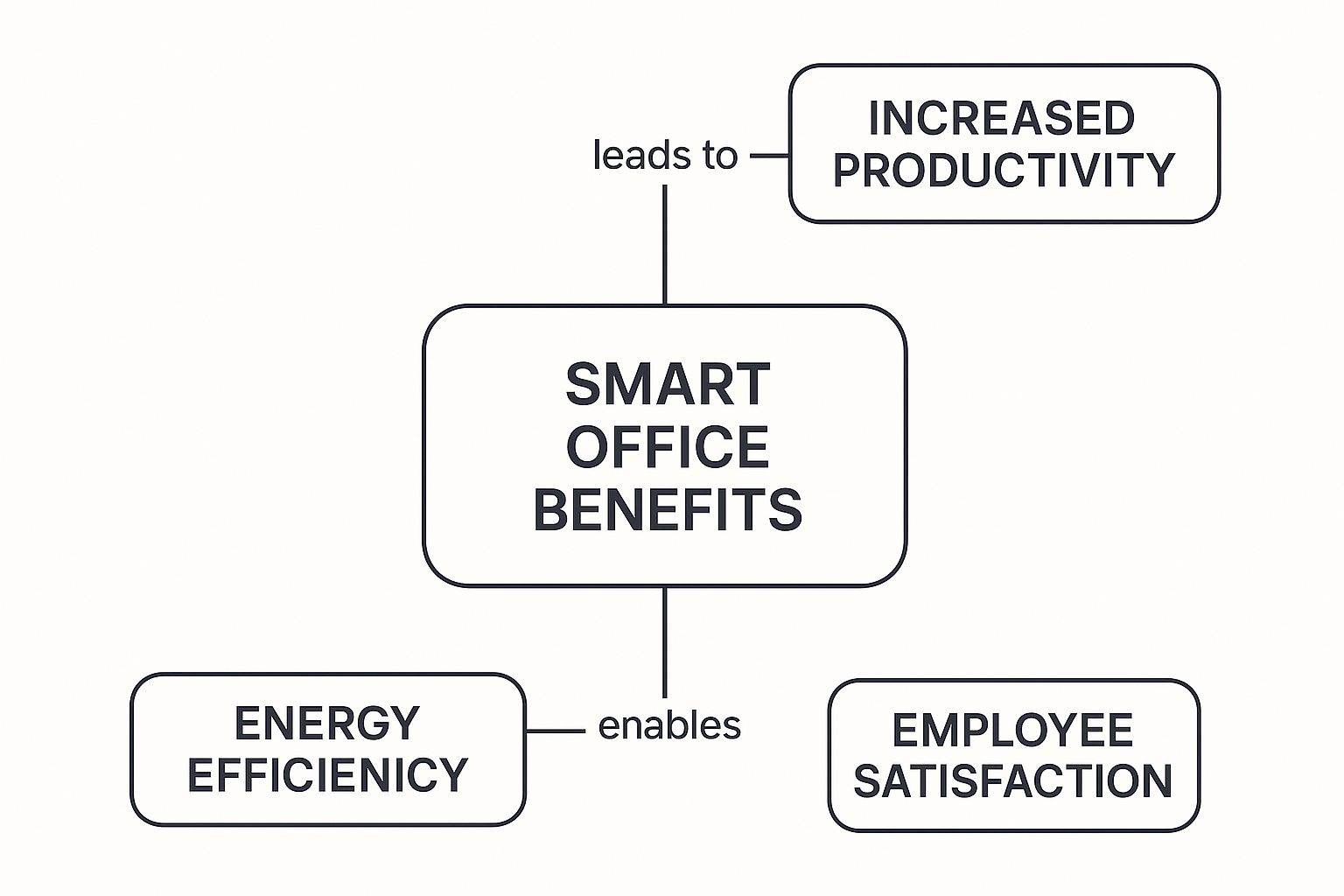
The visual makes it easy to connect the tech components to bigger goals like better productivity, energy savings, and a happier, more comfortable team.
Fostering Seamless Collaboration
Finally, smart office technology is completely changing how teams work together. Collaboration tools aren't just standalone gadgets anymore; they're woven right into the workspace itself.
Take a smart meeting room, for example. When someone books the room on an app, the system kicks into gear automatically.
- The room's calendar is updated instantly.
- The lights and temperature adjust to preset preferences right before the meeting is scheduled to begin.
- The video conferencing system and smartboard turn on by themselves, ready to go.
This kind of automation gets rid of all the frustrating setup time that can kill the momentum of a meeting, letting teams get straight to work. When all these pieces—sensors, climate control, security, and collaboration tools—are working in sync, you get a truly intelligent and responsive environment. To learn more about creating one, feel free to explore our full collection of smart office solutions.
Why Smart Office Adoption Is a Game Changer
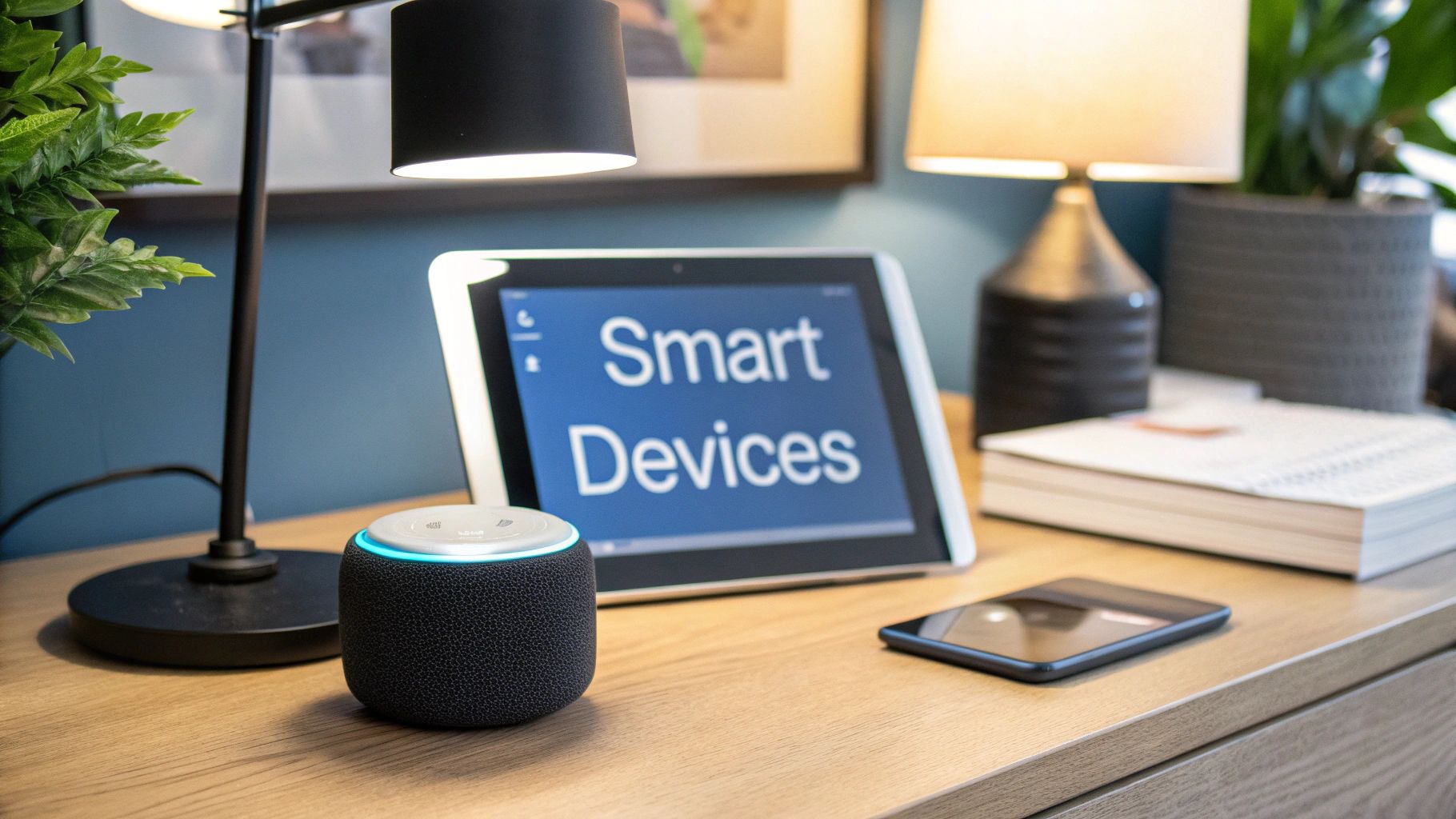
Sure, the gadgets and interconnected systems are cool. But the real reason to care about smart office technology is the tangible results it delivers. This isn't just a tech upgrade; it’s a strategic decision that fundamentally changes how your workplace functions and feels.
We’re moving past the what and digging into the why—the powerful benefits for both your bottom line and your people.
A smart office is a true game changer for productivity. It uses intelligent automation to smooth out the bumps in daily operations, turning raw data into smart decisions that streamline workflows and slash waste. When you automate the tedious stuff, your team is freed up to focus on the creative, high-impact work that actually matters.
These advantages really boil down to three key pillars: boosting operational efficiency, enhancing the employee experience, and driving sustainability. Each one delivers a significant return, proving that a smart office is an asset, not just an expense.
Boosting Operational Efficiency
One of the first things you'll notice with smart office tech is a massive jump in operational efficiency. It all comes down to using real-time data to make better, faster decisions about how the building and its resources are managed.
Think of it like swapping an old paper map for a live GPS. Instead of guessing based on outdated floor plans, facility managers can see exactly how the office is being used at any given moment. That insight is pure gold.
- Optimized Space Usage: Occupancy sensors give you the hard data on which desks, meeting rooms, and common areas are actually popular. You might discover you’re paying for five floors when your team really only needs four, potentially saving a fortune in real estate costs.
- Predictive Maintenance: Smart sensors can keep an eye on the health of crucial equipment like HVAC systems or projectors. Instead of a surprise breakdown disrupting everyone's day, the system flags potential issues ahead of time so maintenance can be handled proactively.
- Streamlined Resource Management: Smart booking systems for desks and rooms put an end to double bookings and "ghost meetings" where a reserved room sits empty. This ensures that valuable space is always available for those who need it.
Enhancing the Employee Experience
Let’s be honest: a truly intelligent workplace is built around its people. Smart technology helps create an environment that’s not just efficient but also comfortable, personalized, and seamless. In today's market, that’s a huge factor in attracting and keeping top talent.
The goal here is to eliminate all those small, daily frustrations that pile up and drain people's energy. When the office works for the employee, not against them, satisfaction and engagement naturally follow.
A human-centric smart office anticipates what people need, from automatically adjusting a desk to the right height to making sure a meeting room is set to the perfect temperature. It’s all about creating a space where employees feel valued and empowered to do their best work.
Personalized comfort is a big piece of the puzzle. Smart lighting can adjust its color and intensity throughout the day to match our natural circadian rhythms, which helps reduce eye strain and keep people alert. And we can finally end the thermostat wars—employees can set their own temperature preferences, which the smart HVAC system can learn and apply to their specific zone.
This same thinking applies to ergonomic furniture. We actually have a whole guide that explores the many standing desk benefits explained, and you can see how perfectly a smart, adaptive workspace complements this approach to well-being.
Driving Sustainability and Cost Savings
Finally, adopting smart office technology is a major win for both the planet and the company's budget. By optimizing energy consumption, these systems can dramatically reduce a building's carbon footprint and generate some serious cost savings.
It’s a shocking number, but the average commercial building wastes an estimated 30% of the energy it consumes. Smart technology is perfectly designed to close that gap.
Intelligent systems make sure energy is only used when and where it's actually needed.
- Automated Lighting: Lights automatically switch off in empty rooms or dim down in areas with plenty of natural sunlight.
- Smart HVAC: The heating and cooling systems adjust based on real-time occupancy and even pull in local weather forecasts, avoiding the costly mistake of conditioning empty spaces.
- Data-Driven Decisions: Facility managers get detailed reports on energy usage, allowing them to pinpoint inefficiencies and roll out targeted reduction strategies.
These benefits make it clear that a smart office is a strategic investment that pays for itself over and over. It creates a workplace that’s more efficient, engaging, and sustainable—which is better for business, for people, and for the environment. By embracing automation with tools like AI-powered scheduling and productivity tools, you’re not just upgrading your office; you’re future-proofing your entire operation.
How to Implement Smart Office Technology
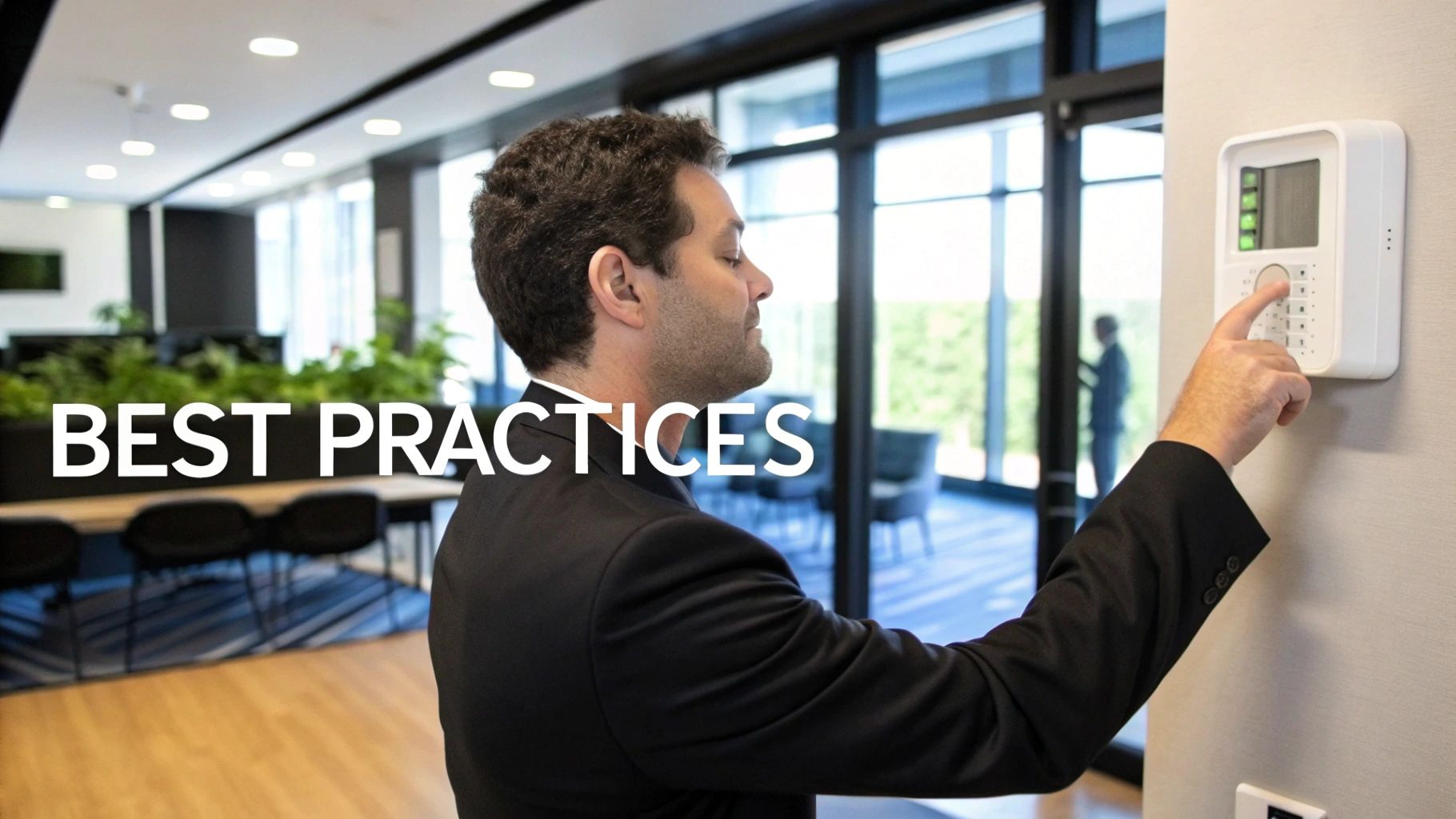
The idea of transforming your entire office into a "smart" space can feel like a massive undertaking. But it doesn't have to be. The key is to avoid a massive, all-at-once overhaul and think strategically.
A successful rollout is less of a tech sprint and more of a well-planned journey. It starts not with gadgets, but with your people. The goal is to solve real-world problems your team faces every single day, ensuring any new tech delivers immediate, noticeable value.
Start by Assessing Your Team's Needs
Before you even think about sensors or software, you need to understand the daily friction points in your office. A thorough assessment is the bedrock of a good smart office strategy. This means getting out there and talking to your employees, watching workflows, and seeing how people actually use the space.
Your goal here is to get past assumptions and gather real information. What are the common complaints? Is finding a meeting room a constant battle? Does the thermostat feel like it's at the center of a never-ending office war? These everyday headaches are your roadmap.
- Survey Your Employees: Go straight to the source. Ask direct questions about their challenges. What tasks are eating up their time? What parts of the office environment hurt their focus?
- Analyze Existing Data: Look at what you already have. Meeting room booking logs and past employee feedback can reveal patterns, like certain spaces being chronically underused.
- Observe Work Patterns: Just watch. See how teams collaborate. Do they need more quiet nooks for deep work or more open, dynamic areas for brainstorming?
Begin with a Pilot Project
Trying to upgrade the entire building at once is a recipe for disaster—for your budget and your team's sanity. A much better approach is to start small with a contained pilot project. This lets you test the waters, get feedback, and prove the concept on a manageable scale.
A single smart meeting room is a fantastic place to start. It’s a high-traffic area where the benefits of automation—like one-click video conferencing, automated lighting, and dead-simple booking—are obvious right away. A win here builds momentum and makes a powerful case for expanding further.
A successful pilot project acts as a proof of concept. It turns abstract ideas about a "smart office" into a concrete experience that people can see and feel, which is the best way to get buy-in from everyone.
This kind of controlled experiment gives you a low-risk way to iron out the kinks. You’ll quickly learn what works for your company culture and what doesn’t, all before you commit to a major investment.
Choose Scalable and Interoperable Tech
As you pick the technology for your pilot, always keep an eye on the future. It’s easy to grab a cool gadget that solves one specific problem, but this can lead you down a path to a messy, fragmented system that’s a nightmare to manage. You're trying to build an ecosystem, not just a collection of random devices.
Look for solutions that can work together and scale as you grow. This idea, called interoperability, is crucial. Can your room booking system talk to your smart lights and thermostat? Does the platform you're considering play nicely with a wide range of third-party sensors?
Thinking about scalability from day one saves you from getting locked into a system that can’t grow with your company. A solid foundation of compatible tech makes it infinitely easier to add new features down the road.
Prioritize Security and Training
Adding dozens or even hundreds of new connected devices to your network naturally raises security questions. Security can't be an afterthought; it has to be a top priority right from the start. Only work with reputable vendors who have a strong security track record, and make sure every device is properly set up with strong passwords and the latest software.
Finally, remember that the most brilliant smart office technology is worthless if your team doesn't know how to use it. A great rollout is as much about people as it is about platforms. Invest time in clear communication and hands-on training so everyone feels confident with the new tools. When you address the human side of things, including well-being as detailed in our office ergonomics checklist for a healthier workspace, you create an environment where technology genuinely supports your team.
Merging Smart Tech with Workplace Ergonomics
A truly intelligent workplace is designed around its people. This is where smart office technology stops being just about automation and efficiency and starts making a real difference in employee well-being. By blending smart systems with the core ideas of ergonomics, companies can build environments that proactively adapt to what each person needs, creating a healthier and more productive team.
This fusion is all about creating a human-centric space where technology makes tangible, personal improvements to the workday. Instead of people having to adjust to a rigid environment, the environment adjusts to them. The payoff goes way beyond simple convenience—it directly boosts physical comfort, focus, and overall job satisfaction.
Personalized Workstations That Adapt to You
One of the best examples of this merger in action is the smart ergonomic workstation. Traditional office furniture is static and one-size-fits-all, but an intelligent desk can transform to meet your specific needs throughout the day. It creates a dynamic and much healthier work experience.
Imagine a desk that actually remembers your perfect sitting and standing heights. With a quick tap on an app or the swipe of a keycard, the desk automatically glides into your saved position. This little bit of magic removes the hassle that often stops people from getting the full benefit of their sit-stand desks.
An adjustable desk, supercharged with smart tech, lets employees switch up their posture without a second thought. Some even have app-based controls that send gentle reminders to stand or sit, encouraging movement and cutting down on the health risks of sitting all day.
This kind of personalization ensures that every employee, no matter their height or work style, can maintain an ideal ergonomic posture. It's a huge step in preventing common workplace issues like chronic back pain and repetitive strain injuries.
Intelligent Lighting That Works with Your Body
Let’s be honest, standard office lighting is pretty awful. It’s often a harsh, one-size-fits-all solution that can lead to eye strain, headaches, and that dreaded afternoon slump. Smart lighting systems offer a more natural and responsive alternative by mimicking the patterns of daylight, a concept known as circadian lighting.
This technology dynamically changes the color temperature and brightness of the lights as the day goes on. For instance:
- Morning: The system emits a cool, blue-toned light that helps suppress melatonin, waking you up and promoting sharp focus to kickstart the day.
- Afternoon: The light shifts to a warmer, softer hue that’s easier on the eyes, helping reduce strain during the final hours of work.
These systems can also use sensors to adjust lighting based on how much natural sunlight is coming in, dimming lights near windows to save energy while keeping illumination consistent. The result is an environment that supports the body's natural rhythms, which can lead to a better mood and higher energy levels.
Climate Control That Ends the Thermostat Wars
Few things cause more office drama than the thermostat. Smart HVAC systems tackle this problem head-on by ditching the single, centrally controlled thermostat for a more personalized approach to climate control.
By dividing the office into smaller micro-zones, these systems can learn the preferences of the people in each area. If one part of the office is always colder or gets blasted by the afternoon sun, the system can automatically compensate. Some advanced platforms even let employees give real-time feedback through an app, telling the system if they’re too hot or cold.
Over time, the system uses this data to get ahead of everyone's needs, creating a comfortable environment without anyone having to touch the thermostat. This proactive approach not only keeps everyone comfortable but also makes the building more energy-efficient by only heating or cooling the areas that actually need it. To go deeper, you can learn more about how to incorporate ergonomic design into your workspace, which complements these smart solutions perfectly.
The Future of Work and Emerging Smart Office Trends
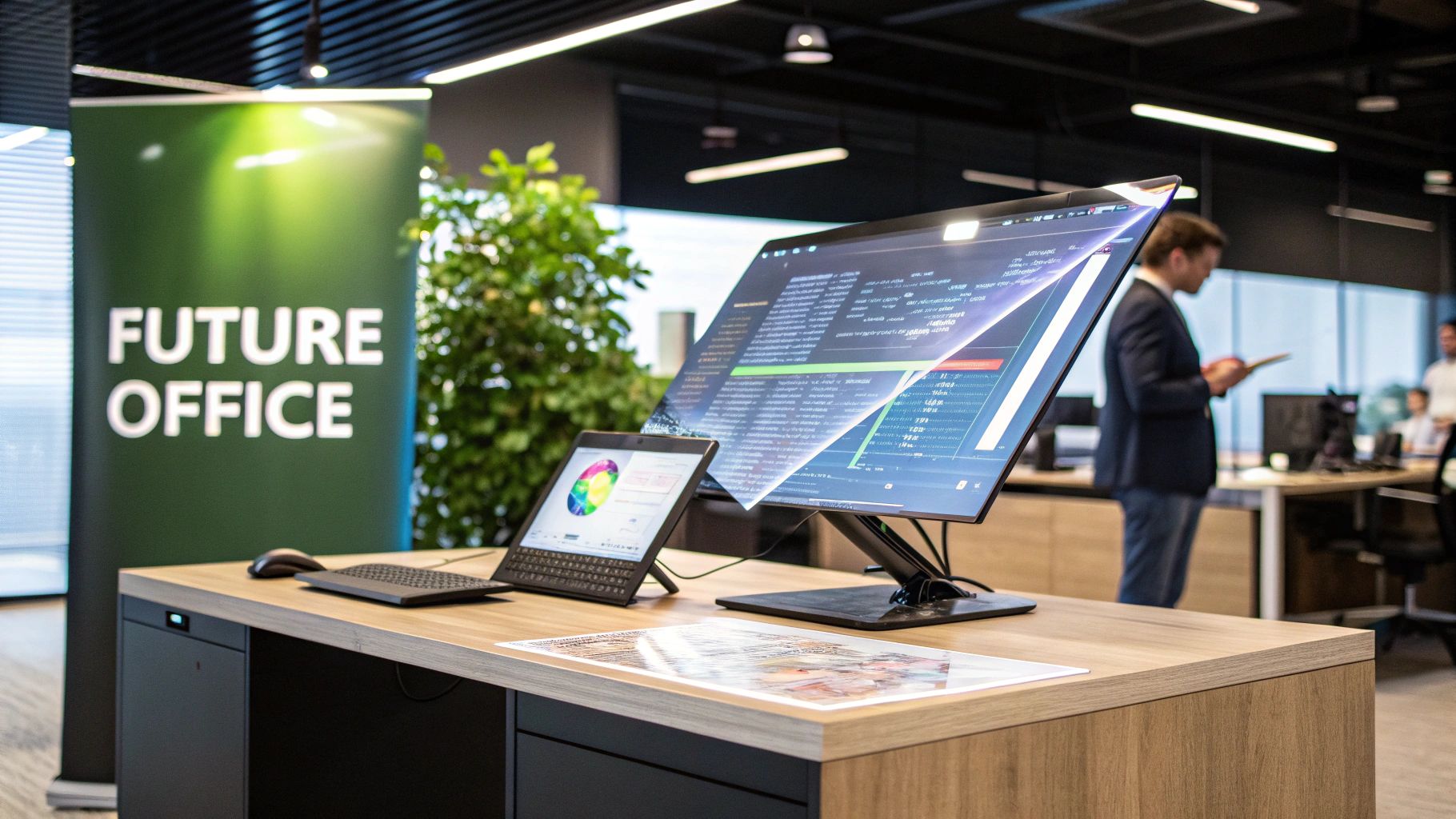
If you think smart offices are just about automated lights and thermostats, get ready for a big shift. The next wave of smart office technology is moving well beyond simple automation. We're talking about creating workspaces that are truly predictive and can adapt on the fly.
This isn't just about connecting a bunch of devices. It's about giving the workplace a digital brain—one that can learn, anticipate, and respond to what people need, sometimes before they even know they need it. The driving force behind this is a much deeper blend of Artificial Intelligence (AI) and machine learning, which are set to completely change how we manage and experience our offices.
The Rise of Predictive and Personalized Spaces
In the near future, the smart office won't just react; it will predict. By crunching historical data on everything from conference room bookings to how often certain desks are used, AI algorithms will start to forecast what the office needs next with startling accuracy.
This opens the door for truly dynamic resource management. Imagine an office that automatically sets up a corner for team collaboration on Tuesday mornings because it knows a specific team always brainstorms then. Or a system that suggests the perfect hot desk for you based on your meeting schedule and how much quiet you need to focus that day.
The core message is clear: smart technology isn't about filling an office with gadgets. It's about creating a responsive, data-driven, and fundamentally more human-centric place to work, where the environment serves the employee, not the other way around.
Digital Twins and Workplace Simulation
Another game-changing trend popping up is the "digital twin"—a virtual, real-time replica of your physical office. This digital model is constantly fed live data from IoT sensors, creating a living, breathing simulation of the entire workplace.
With a digital twin, facilities managers can finally stop guessing and start knowing.
- Test New Layouts: Want to see how a new floor plan will affect foot traffic and where people gather? You can simulate it first, without moving a single piece of furniture.
- Optimize Emergency Responses: Run virtual fire drills to spot bottlenecks and fine-tune safety plans before a real emergency ever happens.
- Model Energy Consumption: Experiment with different lighting and HVAC schedules in the simulation to discover the most efficient settings for the real world.
Looking ahead, the integration of artificial intelligence will redefine workplace interactions, with innovations like AI calling systems becoming standard in the future of smart offices. As you begin this journey, remember that a well-organized space is the foundation. Our guide on how to organize a home office offers principles that scale to any smart workspace.
Frequently Asked Questions About Smart Offices
Whenever businesses start thinking about upgrading their workspaces, a few common questions about smart office technology always seem to pop up. Let's tackle these head-on to clear up the value and practicality of making the switch.
Is Smart Office Technology Only for Large Corporations?
Not anymore. While huge companies were definitely the first to jump on board, the technology has become way more flexible and affordable.
Many of these solutions are now sold "as-a-service," which is a game-changer for small businesses. It means you can add features like smart lighting or a room booking system without a massive upfront investment. The trick is to start small with specific solutions that give you a clear, immediate win.
What Are the Biggest Security Risks?
The two big ones are data privacy and network vulnerability. Think about it: every single connected IoT device is another potential doorway for cyber threats if it isn't locked down properly.
You have to consider the risks of someone getting unauthorized access to occupancy data or, even worse, a hacker taking control of your building's systems. The best way to protect yourself is by working with vendors who have a solid reputation, using strong encryption, and being incredibly strict about keeping everything updated.
Smart office technology is a critical enabler for hybrid work. It provides real-time data on space utilization, allowing teams to manage the unpredictability of office attendance and ensuring resources are used efficiently.
How Does This Tech Support Hybrid Work?
It's pretty much a perfect match for the hybrid model. Desk and room booking systems let your team reserve a spot before they even start their commute, so they know for sure they'll have a place to work when they arrive.
Smart collaboration tools, like integrated video conferencing and digital whiteboards, also help bridge the gap between your in-office crew and remote team members, making it feel like everyone's in the same room.
And it doesn't stop there. Ergonomic tools often tie into these systems. To make sure your team is comfortable and productive, a standing desk height calculator can help them find their perfect settings. A smart desk can then remember those preferences and adjust automatically. This also gives facility managers useful data to optimize everything from cleaning schedules to energy use based on who’s actually in the building on any given day.
Ready to create a smarter, more ergonomic workspace? Explore the full range of smart office solutions from Mount-It to build an office that boosts productivity and well-being. https://www.mount-it.com
